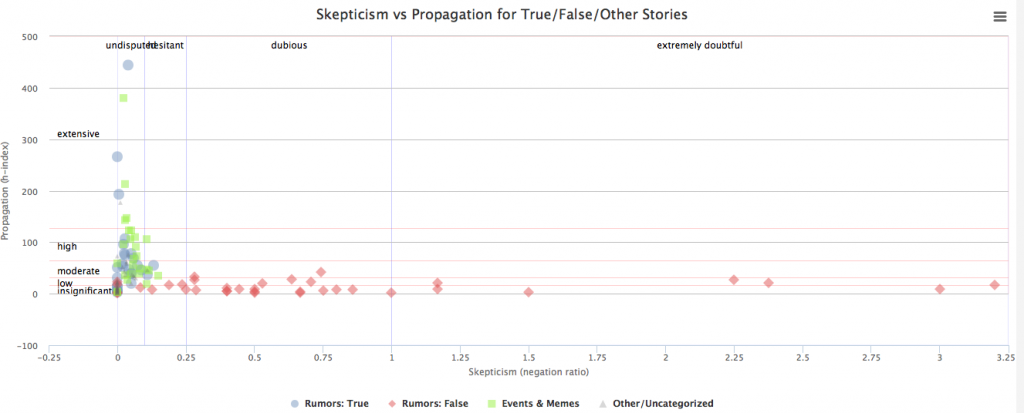On Twitter, claims that receive higher skepticism and lower spread scores are more likely to be false.
On the other hand, claims that receive lower skepticism and higher spread scores are more likely to be true.
The above is a conjecture we wrote in a recent paper entitled Investigating Rumor Propagation with TwitterTrails (currently under review). Feel free to take a look if you want to know more details about our system, but we will write here some of its highlights.
As you may know if you have read our Twitter Trails Blog before, we are developing a Web service that, starting from a tweet or a set of keywords related to a story spreading on Twitter (or a hashtag), it will investigate it and answer automatically some of the basic questions regarding the story. If you are not familiar, you may want to take a look at some of the posts. Or, it can wait until you read this one.
Recently we deployed twittertrails.com a site containing the growing collection of stories and rumors that we investigate. Its front end looks like this:
This is the “condensed view” which allocates one line per story, 20 stories per page. There are over 120 stories collected at this point. Clicking on a title brings you the investigation page with lots of details and visualizations about its spread, its originator, how it burst, who supports it and who refutes it.
Note that on the right side of the condensed view we automatically compute two metrics:
- The spread of a story. This is a logarithmic scale of the h-index of a tweet collection that has currently 5 levels: Extensive, High, Moderate, Low and Insignificant.
- The skepticism level of a story. This is the ratio of the spread of tweets expressing doubt to those not expressing doubt. It has four levels: Undisputed, Hesitant, Dubious and Extremely doubtful.
The initial quote at the top of this post refers to these metrics.
There is also a more detailed, “archive view” of TwitterTrails:
In the main view there are additional tools to select stories, based on time of collection, particular tags, levels of spread and skepticism or keywords.
A few weeks ago we gave a presentation of TwitterTrails at the Computation and Journalism 2014 symposium at Columbia University in NYC. There is a video of our presentation that you can view if interested. In this presentation we noted that false rumors have different pattern of spread on Twitter than true rumors. Below is a graph that shows that difference
The graph displays spread levels vs skepticism levels, and the data points are colored depending on whether a rumor was true (blue), false (red) or something else (green) that cannot be categorized as true or false (e.g., reference to an event or a tweet collection based on a hashtag). The vast majority of the false rumors show insignificant to low spread while at the same time their level of skepticism ranges from dubious to extremely doubtful.
This is remarkable, but it may not be too surprising. As we write in the paper, “Intuitively, this conjecture can be explained as an example of the power of crowd sourcing. Since the ancient times philosophers have argued that people will not willing do bad unless they are guided by irrational impulses, such as anger, fear, confusion or hatred. Therefore, the more people see some false information, the more likely it is that they will either raise an objection or simply decide not to repeat it further.
We make the conjecture specific for Twitter because it may not hold for every social network. In particular, we rely on the user interface for promoting an objection to the same level as the false claim. Twitter’s interface does that; both the claim and its negation will get the same amount of real estate in the a user’s Twitter client. On the other hand, this is not true for Facebook, where a claim gets much greater exposure than a comment, while a comment may be hidden quickly due to follow up comments. So, on Facebook most people may miss an objection to a claim.”
Take a look at TwitterTrails.com and tell us what you think!
We would also be happy to run an investigation for you, if interested.


